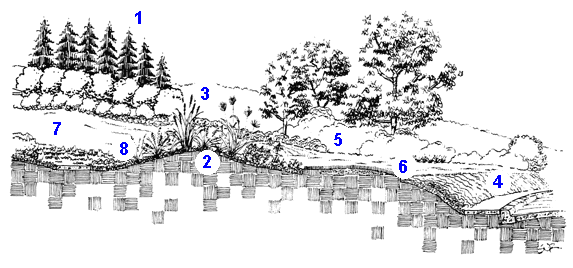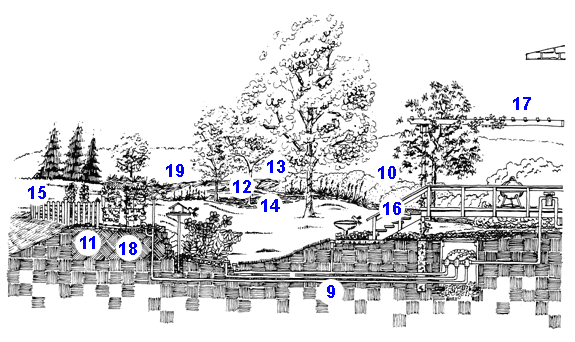G1405
Landscape Sustainability
This NebGuide describes how to use aesthetic, functional and environmentally sound design principles to create a sustainable landscape.
Steven N. Rodie, Extension Landscape Horticulture Specialist
Anne M. Streich, Horticulture Educator
- Aesthetic and Functional Design Principles
- Environmental Design Principles
- Illustrated Sustainable Design Principles in a Residential Landscape, Part A
- Illustrated Sustainable Design Principles in a Residential Landscape, Part B
- Getting Started
“Sustainable landscapes” commonly describes landscapes that support environmental quality and conservation of natural resources. For many people, a sustainable landscape is hard to understand or visualize. Other terms such as xeriscape, native landscape, and environmentally friendly landscape have been used interchangeably to describe sustainable landscapes.
A well-designed sustainable landscape reflects a high level of self-sufficiency. Once established, it should grow and mature virtually on its own — as if nature had planted it. This self-sufficiency can be difficult to attain, however, due to the environmental stresses and artificial conditions placed on plants in urban areas. In addition, many residents may not be comfortable with the informality (less plant pruning, use of native plants which may lack the desirable aesthetic features of typical landscape plants, etc.) normally reflected in a sustainable landscape.
Adjusting to an informal landscape may take time for many homeowners, but implementing just one or a few principles of sustainable design can significantly benefit home landscapes. These benefits may include enhanced landscape beauty; less environmental decline; more effective use of water, pesticides and other chemical resources; more valuable wildlife habitat; and cost savings from reduced maintenance, labor and resource use.
Aesthetic and Functional Design Principles
Many design principles typically are reflected in a well-designed landscape. Although sustainable landscapes may appear more “natural” and less manicured, they still rely on all of the standard design principles to create a visually appealing combination of plants and materials.
Aesthetic principles including accent, contrast, harmony, repetition and unity ensure the design is attractive, visually compatible and has a “sense of fit” with the surrounding landscape.
Functional principles dictate whether the design will be usable and will meet certain health and safety criteria. For example, drainage must be routed away from the foundation of a home; sidewalks and outdoor spaces should be sized appropriately for homeowner and visitor use; and landscapes should include areas dedicated to private, public, and utility needs.
Environmental Design Principles
Environmental design is the third category of design principles. The focus of these principles is to:
1) enhance landscape microclimate;
2) increase biodiversity;
3) reduce resource inputs and resource waste; and
4) maximize reuse of resources.
The diagrams on pages 2 and 3 illustrate how these principles can be implemented in a typical residential landscape.
|
|
Enhance landscape microclimates through:
- channeling or screening winds;
- shading structures and outdoor living areas from the summer sun while providing for winter sun exposure; and
- increasing or decreasing humidity (or the perception of humidity) through adjustments in air movement.
These enhancements can lead to lower energy and water use, healthier plants (which are capable of resisting diseases and insects with less chemical assistance), and more usable outdoor living space.
Biodiversity refers to the natural variety of plants, animals, fungi, and microorganisms found in all ecosystems. Increasing biodiversity, whether in a backyard, neighborhood park, or along regional creeks, brings many benefits to landscapes.
Planting landscapes that more closely reflect native plant communities can enhance biodiversity. To achieve this, develop understory/overstory vegetation similar to the layering of plants in a natural forest. Biodiversity also assumes plants are placed in conditions and environments where they would naturally grow. Additionally, biodiversity can be increased by:
- using plants that provide habitat for wildlife and year-round aesthetic interest;
- considering alternative methods of storm drainage management such as rain gardens and allowing run-off to percolate through porous surfaces, or implementing flood control measures along creeks that are sensitive to existing vegetation and habitat; and
- preserving existing natural areas in urban settings that provide habitat as well as aesthetic or recreational value.
Reducing resources and minimizing waste in a landscape can be accomplished in many ways. For example, by choosing the correct plants and their locations, watering, pruning, and chemical applications will be reduced. Accepting insects and diseases that are not life-threatening to landscape plants (for example, some leaf feeding or leafspot is okay) is another way to reduce chemical use and other resources. Applying mulch to the soil under plants reduces weed growth that in turn reduces chemical treatments and use of gas-powered trimming equipment. In addition, the mulch improves soil quality over time, minimizing water waste caused by run-off and evaporation.
Soils are typically the most misunderstood and undervalued resource in urban landscapes. Soil quality and character significantly affect the growth and health of plants, and should be major considerations in landscape installation.
Whenever previously undisturbed landscape areas are slated for construction, the top 6 inches of soil should be scraped off and stockpiled. Save the soil and reincorporate it as the final layer of soil once construction is completed. Since a substantial amount of root growth occurs in the top 6-12 inches of soil, this reused soil can significantly enhance the establishment and growing conditions for new plants. Drainage and water retention are improved, oxygen storage is increased, and the living organisms in the soil are healthier.
Whenever the topsoil is not available for reuse, due to removal or severe compaction, incorporate organic amendments such as compost into the remaining soil to enhance its ability to support newly established plants.
Maximizing and reusing resources has recently received notable attention in the form of recycling campaigns for everything from newspapers to used tires. Effective sustainable design not only incorporates recycled materials (paving materials, mulches, building materials, etc.), but also addresses how communities can recycle for the good of their landscapes.
Composting can be integrated into a residential backyard garden for kitchen and yard waste or a regional solid waste program aimed at reducing landfill while providing a source of organic matter for city/county park sites.
Getting Started
By implementing the principles outlined in this NebGuide, Nebraska’s residential landscapes can be made more sustainable. Applying even the most basic principles — proper plant selection and placement for example — can benefit the aesthetics, environment and budget of the typical home landscape. Properly selected plants are healthy plants that have fewer insect and disease problems and, therefore, require less maintenance. Properly sized trees and shrubs need little pruning, and drought-tolerant perennials need minimal irrigation.
This publication has been peer reviewed.
Visit the University of Nebraska–Lincoln Extension Publications Web site for more publications.
Index: Horticulture
Miscellaneous
2000, Revised March 2009

